阅读:0
听报道
推文人 | 冷萱
原文信息:David Autor, DavidDorn, Gordon Hanson, Gary Pisano and Pian Shu. "Foreign Competition andDomestic Innovation: Evidence from U.S. Patents." American Economic Review: Insights, forthcoming.
一、引言
此前,我们推送过一篇关于创新能否帮助美国制造业抵御来自中国的进口竞争的推文,文章认为美国创新抵御了来自中国的进口冲击(Hombert and Matray ,2018)。有一系列的文献探讨了来自中国的进口竞争对美国制造业就业人数的影响(Bernard et al., 2006; Autor et al., 2013, 2014; Pierce and Schott, 2016; Acemoglu et al.,),而本文则从进口竞争的角度分析其对美国企业层面创新的影响。
关于竞争如何影响创新,Dasgupta and Stiglitz (1980)认为更具竞争的产品市场会降低企业边际利润,进而企业将减少对创新的投入。Aghion et al.(2005)进一步分析认为企业创新对竞争的反应取决于企业间技术进步的分散程度。当分散程度越低,激烈的竞争将会促进企业创新以摆脱竞争;当分散程度越高,激烈的竞争将会抑制落后的企业创新。
本文先分析了来自中国进口增加对美国企业竞争压力的影响:第一,降低了在国内和全球的销售额;第二,缩小了企业账面价值;第三,减少了劳动力和资本投入的购买;第四,成比例的降低了R&D的投入。再者,呈现了竞争压力的上升导致了美国创新产出的下降。通过替换衡量贸易风险的指标,结果依然发现来自中国的进口与美国企业创新之间存在显著的负相关系。最后,作者进一步分析了进口竞争负面影响集中在最初生产率和利润率较低的企业。
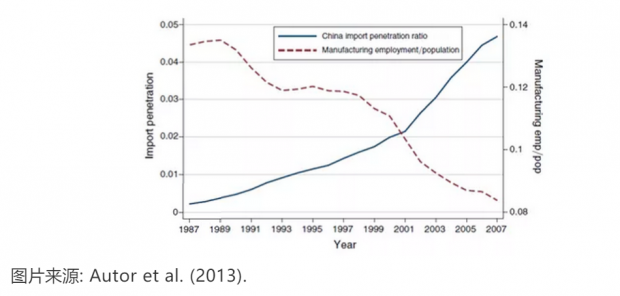
二、贸易风险的衡量
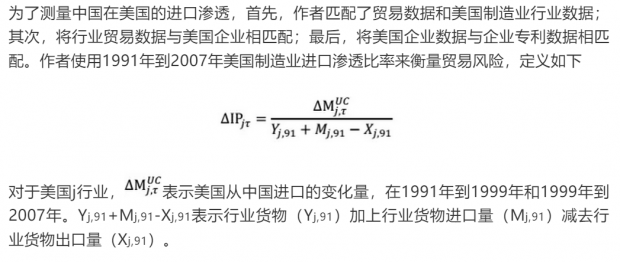
三、进口与竞争压力
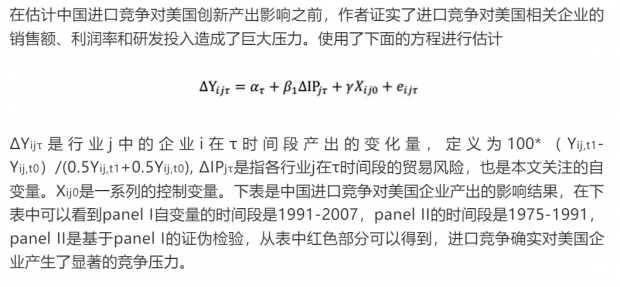
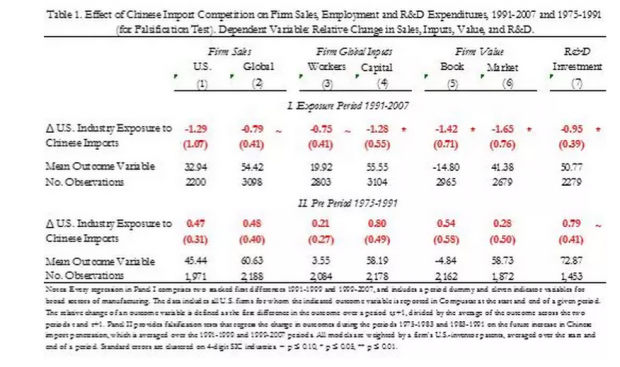
四、进口竞争与创新
(1)基准回归
在回归之前,作者用一张图呈现了美国企业专利数和中国进口竞争的变化趋势,显示从1991年开始中国开始对美国展开贸易。在2000年后,中国对美国出口的贸易数量进一步上升,而美国企业的创新数据开始逐步下滑。
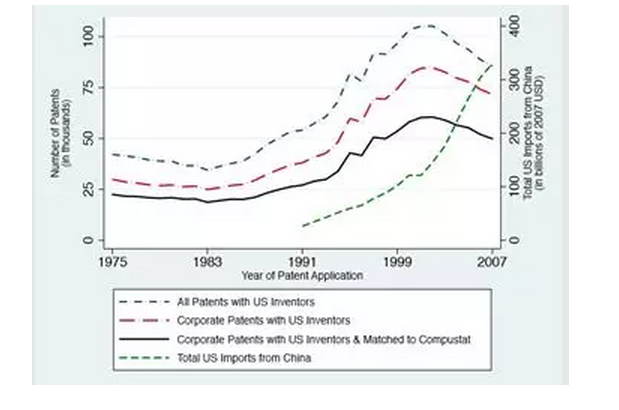
在表2呈现的结果中,除a和c以外,其他均使用了IV估计。文章借鉴国际贸易经济研究中的识别策略,使用其他八个高收入国家受到中国进口冲击的影响作为工具变量(Autor, Dorn, and Hanson,2013; Hombert and Matray ,2018),因为这八个国家受到的进口冲击与美国非常相似,这八个国家分别是:澳大利亚、丹麦、芬兰、德国、日本、新西兰、西班牙和瑞士。IV定义如下:

表2进行了63个回归,均只是汇报了进口竞争这一变量的系数。从每一行来看,b,d到i在逐步加入控制变量;从每一列来看,作者将样本按照美国受到中国进口竞争前后划分为不同的时间段进行分析。最后得到的结论是1999年后,来自中国进口的竞争显著负向的影响到了美国企业的创新。
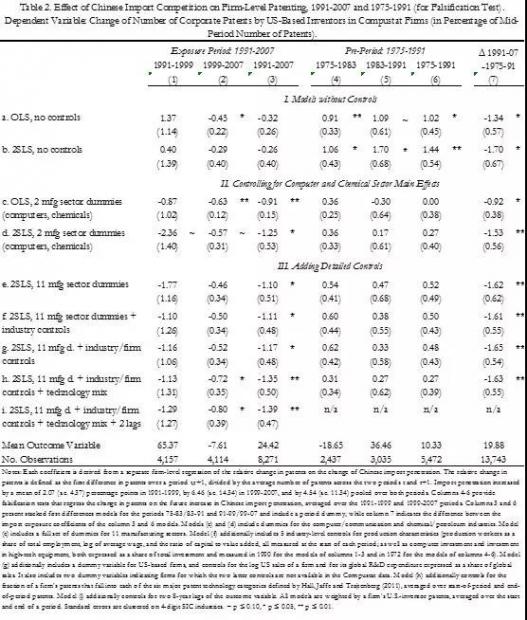
(2)异质性分析
为了分析竞争对企业创新影响的异质性,作者将企业按照人均销售、人均资本、资本利润和负债是否高于均值分别划分为了两个子样本,以探究实力强大的企业(高人均销售额、高人均资本、高资本利润和低负债)在面对进口冲击时,创新表现是否与实力较弱企业存在差异。下表是估计结果,红色部分是我们关注的系数。其结果暗含的意思与Melitz (2003)曾得出的结论一样:生产率越高的企业在全球化进程中的地位也将越高。
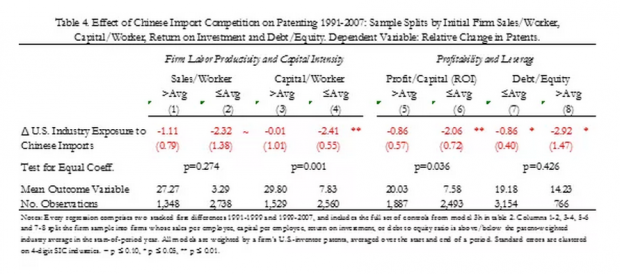
五、总结与讨论
本文分析了来自中国的进口竞争如何影响了美国企业的创新投入和创新产出。在考虑了行业趋势变化这一因素后,仍然得到稳健的结果,即中国进口竞争对美国企业层面创新有显著的负向影响。但来自中国的进口竞争不会影响到美国大学和政府单位的创新。作者在最后进行异质性分析的时候发现进口竞争只会对相对较弱的美国企业产生显著的影响。在这之前,也有学者分析了来自中国等进口竞争对其他国家的影响。如Dauth et al.(2014)分析了中国和东欧贸易对德国劳动市场的影响,结果发现随着贸易量的增加,导致德国生产进口工业的地区出现大量失业。Kueng et al. (2016)发现来自中国的进口增加,导致加拿大企业的创新下降。随着中国的崛起,学者们发现来自中国的进口竞争影响到了一些发达国家的经济,如就业、企业生产率和创新等。
注:原文data和code可前往David Dorn主页下载。
参考文献
Hombert, Johan and Adrien Matray, “Can Innovation Help U.S. Manufacturing Firms Escape Import Competition from China?,” The Journal of Finance, 2018, Forthcoming.
Bernard, Andrew B., J. Bradford Jensen, and Peter K. Schott, “Survival of the best fit: Exposure to low-wage countries and the (uneven) growth of U.S. manufacturing plants,”Journal of International Economics, January 2006, 68 (1), 219-237.
Autor, David H, David Dorn, and Gordon H Hanson, “The China Syndrome: Local Labor Market Effects of Import Competition in the United States,” American Economic Review, October2013, 103 (6), 2121-2168.
Autor, David H., David Dorn, Gordon H. Hanson, and Jae Song, “Trade Adjustment: Worker-Level Evidence,” The Quarterly Journal of Economics, November 2014, 129 (4), 1799-1860.
Pierce, Justin R. and Peter K. Schott, “The Surprisingly Swift Decline of US Manufacturing Employment,”American Economic Review, July 2016, 106 (7), 1632-1662.
Acemoglu, Daron, David Autor, David Dorn, Gordon H. Hanson, and Brendan Price, “Import Competition and the Great US Employment Sag of the 2000s,” Journal of Labor Economics, December 2015, 34 (S1), S141-S198.
Dasgupta, Partha and Joseph Stiglitz, “Industrial Structure and the Nature of Innovative Activity,” The Economic Journal, 1980, 90 (358), 266-293.
Aghion, Nick Bloom, Richard Blundell, Rachel Gri th, and Peter Howitt, “Competition and Innovation: an Inverted-U Relationship,” The Quarterly Journal of Economics, 2005, 120 (2), 701-728.
Melitz, Marc J., “The Impact of Trade on Intra-Industry Reallocations and Aggregate Industry Productivity,” Econometrica, October 2003, 71 (6), 1695-1725.
Dauth, Wolfgang, Sebastian Findeisen, and Jens Suedekum, “The Rise of the East and the Far East: German Labor Markets and Trade Integration,” Journal of the European Economic Association, December 2014, 12 (6), 1643-1675.
Kueng, Lorenz, Nicholas Li, and Mu-Jeung Yang, “The Impact of Emerging Market Competition on Innovation and Business Strategy,” NBER Working Paper No. 22840, November 2016.
Abstract
The manufacturing sector accounts for more than three-quarters of U.S. corporate patents. The major competitive shock to this sector emanating from China's economic ascent could in theory either augment or stifle U.S. innovation. We use three decades of U.S. patents matched to corporate owners to quantify how foreign competition affects domestic innovation. Rising import exposure intensifies competitive pressure, reducing sales, profitability, and R&D expenditure at U.S. firms. Accounting for confounding sectoral patenting trends, we show that foreign competition robustly curtails U.S. patent production. This effect is larger among firms that were initially less profitable and less capital-intensive.
话题:
0
推荐
财新博客版权声明:财新博客所发布文章及图片之版权属博主本人及/或相关权利人所有,未经博主及/或相关权利人单独授权,任何网站、平面媒体不得予以转载。财新网对相关媒体的网站信息内容转载授权并不包括财新博客的文章及图片。博客文章均为作者个人观点,不代表财新网的立场和观点。

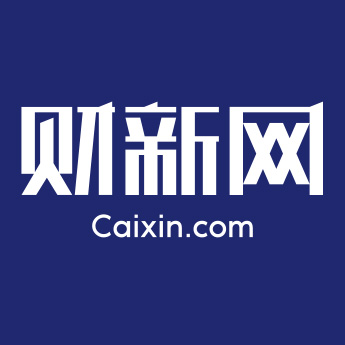
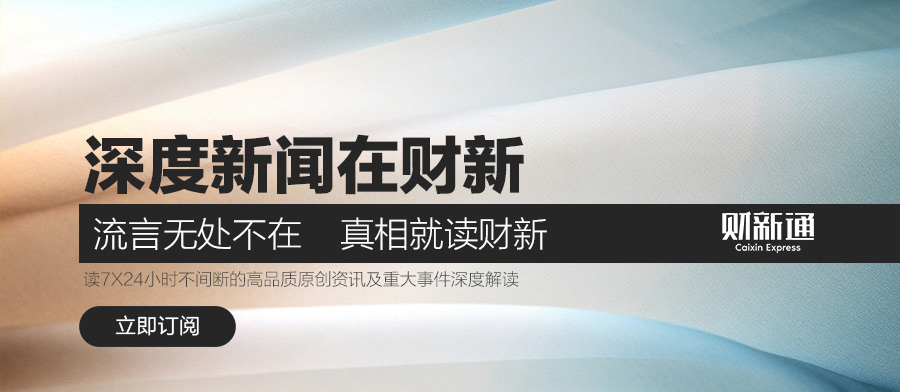
 京公网安备 11010502034662号
京公网安备 11010502034662号 